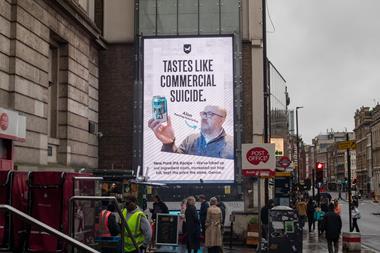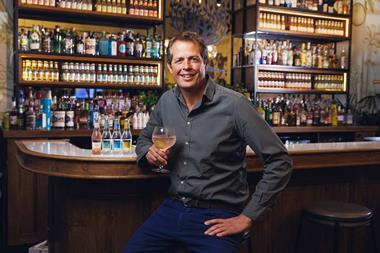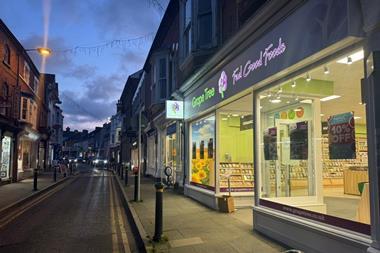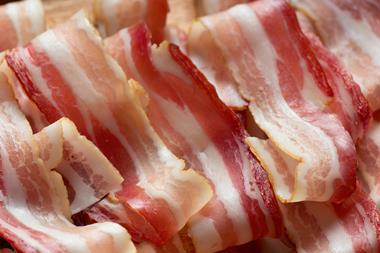Getting a bottle of wine from the back of the supermarket on to the shelf can be as expensive as transporting it all the way from Australia to the store.
If the wine is not in stock  that is, if it is not on the shelf when the customer wants it  there's a good chance it's sitting around somewhere in the backroom.
Apply this theory to the 25,000 or so other products in a typical supermarket and translate it into hard cash, and you can see a massive cost saving opportunity.
Tesco spends £2.5bn on distribution a year, and "approaching 50%" of this is spent on instore logistics says supply chain director David Wild. Given that Tesco turns over £25.7bn a year, that's almost 5% of sales tied up in the last 50 yards.
Which begs the question, why are the multiples expending so much energy cutting upstream logistics costs with initiatives such as factory gate pricing, when the big money can be saved in their own backyards?
Moreover, don't suppliers have a right to feel angry if they are delivering the right amount of product at the right time, and then losing sales because retailers can't get it on the shelf?
No, say retailers, because the buck doesn't stop with them. Manufacturers, retailers and third party logistics service providers have to work together to make deliveries as store-friendly as possible.
And that's not simply a question of ready-to-display packaging, or better labour scheduling instore, but looking at how changes further up the supply chain could impact on the last 50 yards.
David Godsell, Christian Salvesen food and consumer division marketing and strategic development director, says this can mean identifying the best time to implement a process that has to take place somewhere along the supply chain. Take cans of beans, which have, at some point, to be put into a dolly/roll cage so they can be wheeled on to the shopfloor. Should this process take place in the factory or in the store's backroom?
While it may be cheaper to fill the dollies in the factory, for example, the savings could be cancelled out by the cost of transporting the goods inefficiently in the dollies to the store in the first place.
By rights, onshelf availability should be improving as stores get more frequent deliveries, orders are automatically generated by sales, and forecasting accuracy improves. Likewise, reductions in backroom space should logically dictate that more stock gets on to the sales floor more quickly.
But there is scant evidence to suggest any meaningful reduction in out of stocks across the sector as a result of these initiatives. Indeed, a major new study into this area from Insight Research reveals the problem of availability is getting worse.
Moreover, continuous replenishment can actually exacerbate the problem, claims Insight Research partner Dan Munford. "The reality of more frequent deliveries can compound mistakes. Rollers and pallets build up with no one to manage them efficiently and shelf stackers spend too much time searching for products."
The JIT (just in time) approach to supply chain management does not guarantee better onshelf availability, says Morrisons' joint MD Bob Stott. "A bit of buffer stock is not necessarily a bad thing." As one chilled food supplier observes, "In my experience, JIT is known as JTFL Â just too f**king late..." Some retailers err on the cautious side because of concerns over wastage. It is also hard to produce accurate forecasts in a category so promotionally driven, he says. "So availability isn't great."
Worse, store backrooms can be a "complete nightmare, with products piled high, things getting damaged and the stuff you are looking for at the bottom of a rollcage somewhere".
Safeway's supply chain operations director Mark Aylwin admits half the problems can be tackled with a bit of common sense. "You roll a cage on to the sales floor and replenish a shelf. Then you have to wheel it back into the storeroom, still half full of product. When that shelf needs restocking, you've got someone hunting around the backroom looking for it." As part of the chain's new Store Replenishment Process system, product returning to the backroom goes back in cages labelled by aisle. Similarly, by identifying products that need restocking more than once a day, the backroom can be reorganised so the crucial 500 or so lines are grouped together and easily located.
"We've done a massive amount of work on the backroom," says Aylwin. "It's all very well saying that the supply chain of the future won't have a backroom. That's just not realistic given congestion charges and restrictions on overnight deliveries."
Every backroom has a planogram
Under the new regime, every store backroom has been planogrammed and ordering and delivery schedules have been tailored to match stores' individual sales patterns. "There's potentially a 6% sales benefit to be had here," says Aylwin.
Handheld computers scan barcodes at the shelf and tell staff what stock remains in the backroom and when the next order is expected. Space has been reallocated so, where possible, there is sufficient stock on the shelf to meet a day's sales.
A key issue, says Somerfield's group logistics director Martin Oakes, is the mismatch between pack sizes despatched from factories and packs on display instore. "If you can only fit three or six items on the shelf, a 24-pack is not much use." The problem has been compounded as the multiples develop smaller formats with even less space on the shelf.
In some cases, problems can be resolved by more sensible ordering patterns, says Accenture partner David Sharpe. "If you sell 20 crates of tomatoes a day, instead of ordering 20 and putting half in the store, why not order 10 in the morning and 10 in the afternoon?"
Another solution being explored is having trays only 80% or 90% full, so leftover products can be added to the new tray.
"My vision," says Oakes, "is that you don't have core stock in the backroom, just bulk items that need replenishing more than once a day, plus items on promotion."
However, the single most important step in improving onshelf availability, he says, is visibility of backstock  that is knowing exactly what is in the store and whether it is on the shelf or not. "Instore logistics is a priority and we're investing substantially."
Sainsbury remains coy about the precise details of its work on instore replenishment, but claims a complete overhaul of its distribution network will have a significant impact on onshelf availability.
Business focus manager for instore supply chain Dominic Price agrees that accuracy of backstock is critical: "We're working to design a new inventory management system instore which will help to deliver significant benefits and we have a highly reliable onshelf availability monitor that will give us tremendous information to prioritise availability on our fastest selling lines."
Initiatives such as radio frequency tagging will also play a key role by "maximising product identification", adds Price.
All sides agree there is no silver bullet to tackle the last 50 yards, however. As Tesco's David Wild observes: "The main problem with a store is the customers. They get in the way! It's not an industrial environment so there is always going to be a cost incurred there. The question is, how can we reduce it?"
Perhaps the question retailers should be addressing, says Insight Research's Munford, is who is actually responsible for instore replenishment? There must be something amiss, he argues, when "the most expensive and crucial part of the supply chain relies on the lowest paid and least motivated workers".
Perhaps the time has come to relinquish control of the last 50 yards and put it in the hands of logistics experts? Retailers are happy to let third party logistics providers handle their primary and secondary distribution, says Salvesen's Godsell. "Why not give us a crack at the backroom as well?"
{{ANALYSIS }}
If the wine is not in stock  that is, if it is not on the shelf when the customer wants it  there's a good chance it's sitting around somewhere in the backroom.
Apply this theory to the 25,000 or so other products in a typical supermarket and translate it into hard cash, and you can see a massive cost saving opportunity.
Tesco spends £2.5bn on distribution a year, and "approaching 50%" of this is spent on instore logistics says supply chain director David Wild. Given that Tesco turns over £25.7bn a year, that's almost 5% of sales tied up in the last 50 yards.
Which begs the question, why are the multiples expending so much energy cutting upstream logistics costs with initiatives such as factory gate pricing, when the big money can be saved in their own backyards?
Moreover, don't suppliers have a right to feel angry if they are delivering the right amount of product at the right time, and then losing sales because retailers can't get it on the shelf?
No, say retailers, because the buck doesn't stop with them. Manufacturers, retailers and third party logistics service providers have to work together to make deliveries as store-friendly as possible.
And that's not simply a question of ready-to-display packaging, or better labour scheduling instore, but looking at how changes further up the supply chain could impact on the last 50 yards.
David Godsell, Christian Salvesen food and consumer division marketing and strategic development director, says this can mean identifying the best time to implement a process that has to take place somewhere along the supply chain. Take cans of beans, which have, at some point, to be put into a dolly/roll cage so they can be wheeled on to the shopfloor. Should this process take place in the factory or in the store's backroom?
While it may be cheaper to fill the dollies in the factory, for example, the savings could be cancelled out by the cost of transporting the goods inefficiently in the dollies to the store in the first place.
By rights, onshelf availability should be improving as stores get more frequent deliveries, orders are automatically generated by sales, and forecasting accuracy improves. Likewise, reductions in backroom space should logically dictate that more stock gets on to the sales floor more quickly.
But there is scant evidence to suggest any meaningful reduction in out of stocks across the sector as a result of these initiatives. Indeed, a major new study into this area from Insight Research reveals the problem of availability is getting worse.
Moreover, continuous replenishment can actually exacerbate the problem, claims Insight Research partner Dan Munford. "The reality of more frequent deliveries can compound mistakes. Rollers and pallets build up with no one to manage them efficiently and shelf stackers spend too much time searching for products."
The JIT (just in time) approach to supply chain management does not guarantee better onshelf availability, says Morrisons' joint MD Bob Stott. "A bit of buffer stock is not necessarily a bad thing." As one chilled food supplier observes, "In my experience, JIT is known as JTFL Â just too f**king late..." Some retailers err on the cautious side because of concerns over wastage. It is also hard to produce accurate forecasts in a category so promotionally driven, he says. "So availability isn't great."
Worse, store backrooms can be a "complete nightmare, with products piled high, things getting damaged and the stuff you are looking for at the bottom of a rollcage somewhere".
Safeway's supply chain operations director Mark Aylwin admits half the problems can be tackled with a bit of common sense. "You roll a cage on to the sales floor and replenish a shelf. Then you have to wheel it back into the storeroom, still half full of product. When that shelf needs restocking, you've got someone hunting around the backroom looking for it." As part of the chain's new Store Replenishment Process system, product returning to the backroom goes back in cages labelled by aisle. Similarly, by identifying products that need restocking more than once a day, the backroom can be reorganised so the crucial 500 or so lines are grouped together and easily located.
"We've done a massive amount of work on the backroom," says Aylwin. "It's all very well saying that the supply chain of the future won't have a backroom. That's just not realistic given congestion charges and restrictions on overnight deliveries."
Every backroom has a planogram
Under the new regime, every store backroom has been planogrammed and ordering and delivery schedules have been tailored to match stores' individual sales patterns. "There's potentially a 6% sales benefit to be had here," says Aylwin.
Handheld computers scan barcodes at the shelf and tell staff what stock remains in the backroom and when the next order is expected. Space has been reallocated so, where possible, there is sufficient stock on the shelf to meet a day's sales.
A key issue, says Somerfield's group logistics director Martin Oakes, is the mismatch between pack sizes despatched from factories and packs on display instore. "If you can only fit three or six items on the shelf, a 24-pack is not much use." The problem has been compounded as the multiples develop smaller formats with even less space on the shelf.
In some cases, problems can be resolved by more sensible ordering patterns, says Accenture partner David Sharpe. "If you sell 20 crates of tomatoes a day, instead of ordering 20 and putting half in the store, why not order 10 in the morning and 10 in the afternoon?"
Another solution being explored is having trays only 80% or 90% full, so leftover products can be added to the new tray.
"My vision," says Oakes, "is that you don't have core stock in the backroom, just bulk items that need replenishing more than once a day, plus items on promotion."
However, the single most important step in improving onshelf availability, he says, is visibility of backstock  that is knowing exactly what is in the store and whether it is on the shelf or not. "Instore logistics is a priority and we're investing substantially."
Sainsbury remains coy about the precise details of its work on instore replenishment, but claims a complete overhaul of its distribution network will have a significant impact on onshelf availability.
Business focus manager for instore supply chain Dominic Price agrees that accuracy of backstock is critical: "We're working to design a new inventory management system instore which will help to deliver significant benefits and we have a highly reliable onshelf availability monitor that will give us tremendous information to prioritise availability on our fastest selling lines."
Initiatives such as radio frequency tagging will also play a key role by "maximising product identification", adds Price.
All sides agree there is no silver bullet to tackle the last 50 yards, however. As Tesco's David Wild observes: "The main problem with a store is the customers. They get in the way! It's not an industrial environment so there is always going to be a cost incurred there. The question is, how can we reduce it?"
Perhaps the question retailers should be addressing, says Insight Research's Munford, is who is actually responsible for instore replenishment? There must be something amiss, he argues, when "the most expensive and crucial part of the supply chain relies on the lowest paid and least motivated workers".
Perhaps the time has come to relinquish control of the last 50 yards and put it in the hands of logistics experts? Retailers are happy to let third party logistics providers handle their primary and secondary distribution, says Salvesen's Godsell. "Why not give us a crack at the backroom as well?"
{{ANALYSIS }}



















No comments yet